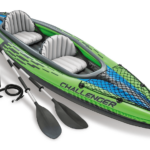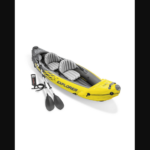One of the most important considerations for kayakers is the kayak weight limit. It’s important to know how much gear you can bring with you without sinking or slowing you down. What is the standard kayak weight limit?
A typical recreational kayak has a weight limit of around 250 to 300 pounds. A sea or touring kayak has a 350-pound limit. The weight limit of a typical sit-on-top kayak ranges from 350 to 400 pounds. A tandem kayak has the highest weight limit that ranges from 500 to 600 pounds.
You must not exceed a kayak’s weight limit. If you do, the kayak will sink lower into the water, and you will be compromising your stability. It will be easy for the kayak to capsize when you start paddling.
Read on to learn more about the weight limits of kayaks and how to calculate your kayak’s weight limit.
Kayak Weight Limit

All kayaks sold in the market have their own particular weight limits. The weight limit of an average recreational kayak is from 250 to 300 pounds. Touring or sea kayaks have weight limits of 350 pounds. The weight limit of a typical sit-on-top kayak ranges from 350 to 400 pounds. A typical tandem kayak weight limit ranges from 500 to 600 pounds.
If you are kayaking and want to remain above water, your weight and the weight of your gear should be below the kayak’s weight limit. Certainly, the total weight should not exceed this limit, or you will readily sink to the bottom.
While there is no industry standard regarding the weight limit for kayaks, it is normally calculated using the kayak’s length, width, and water displacement volume.
Several things will happen if you exceed the kayak’s weight limit. The kayak may not get water-logged, but the excess weight will cause the kayak to sink lower into the water and compromise its stability. If you begin to paddle, your kayak will easily capsize.
Additionally, kayaks equipped with many features and are more expensive tend to be heavier than the average kayaks. They can have a dry weight of more than 225 pounds. If you have a 60-pound solo kayak, you will have to think about a kayak cart to transfer it to and from the water.
The Real Meaning of the Kayak Weight Limit
A kayak’s weight limit is the number or figure assigned to it by its manufacturer. This figure is indicated to help kayakers determine the type of boat that will fit them. The number also shows kayakers the amount of gear that they can take with them on the boat.
This weight capacity should be stamped on every kayak sold in the market. However, no industry standard determines the weight capacity of kayaks. Every kayak builder has their own way of determining their weight, causing confusion among paddlers.
In general, the weight capacity of a kayak indicates the maximum weight it can carry and still stay afloat. That means, if the weight limit of a kayak is 250 pounds, you should not load it more than that weight if you want it to remain afloat.
So, if your weight is 150 pounds, the total weight of gear and equipment that you can take with you should not exceed 100 pounds. It would be better if you will not reach the maximum of 250 pounds for safety reasons.
Sure, the boat will stay afloat while it is carrying its maximum weight limit. However, its stability and maneuverability will suffer because of the weight it is carrying. This is the reason why the total weight a kayak should carry should be less than its weight limit.
Calculating the Right Kayak Size
There are two basic ways of calculating the kayak that will suit you. One is by considering your weight and the weight of gear and equipment that you will be carrying. Based on these weights, you should choose a kayak with a maximum weight capacity of around 125 pounds more than your actual weight.
The other way is by using a rule of thumb for determining the kayak size: look for the maximum capacity rating suggested by the kayak maker and then reduce that number by around 30 to 35%.
The reason for this 30 to 35% reduction is that the kayak’s usable weight limit or performance should be at least 30 percent below the maximum weight capacity rating that its maker has recommended.
This maximum weight capacity is the weight limit of the kayak when it is fully loaded. Remember that when the kayak is fully loaded, its ride in the water will be shallow. Sinking or capsizing is a likely possibility in this condition. The kayak will also be unstable if it is fully loaded.
Factors that Determine the Right Kayak Weight
The weight limit of a kayak is dependent on three factors:
- Length of the kayak
- Width of the kayak
- Water displacement (volume of water displaced by the kayak)
Builders of kayaks use these three basic measurements and boat engineering formulas to determine the maximum weight capacity of kayaks. However, the boating industry has not adopted a standard for kayak makers to determine the maximum weight limits of the kayak. Every kayak maker uses its own system of measurement.
How Your Weight Affects the Kayak
A kayak’s weight limit tells you how much it can take and still float. That is just floating and not about being stable and safe on the water. So, if your weight is 250 pounds, that doesn’t mean a 250-pound kayak can safely float you on the water.
This point is crucial on sit-on-top kayaks, where only the topmost part of the kayak is above the waterline. With most of the kayak under the water, padding this type of kayak is already difficult. It’s easy to capsize when you’re not an adequate paddler.
So, when you see the indicated maximum weight on the kayak, it does not refer only to your body weight but all the things you are wearing and carrying, including the paddle. In other words, if the kayak is rated at 250 pounds and you weigh about that much, you can’t use that kayak. Go for a higher-rated kayak using the rule of thumb described above.
Sample Kayaks with Their Weight Limits

1. Intex Excursion Pro Kayak, Professional Series Inflatable Fishing Kayak
Click here to see it on Amazon.
This is a super tough kayak made of laminate PVC with a polyester core. It is lightweight but highly resistant to impact, sunlight, and abrasion. The total weight capacity of this kayak is 400 pounds.
2. Pelican Sit-on-Top Kayak – Sentinel 100X
Click here to see it on Amazon.
This is a recreational compact kayak measuring 9 feet and 6 inches. Its compact size makes it easy to store. This kayak weighs only 42 pounds, but its maximum weight capacity is 275 pounds.
3. ADVANCED ELEMENTS AdvancedFrame Inflatable Kayak
Click here to see it on Amazon.
This kayak measures 10 feet and 5 inches. Its built-in aluminum ribs define its bow and stern and improve its tracking. This kayak weighs only 36 pounds, but it can carry a maximum weight of 300 pounds.
A Kayak Can Only Take 65% of Your Weight
If you use the 30 to 35% rule of thumb, it will provide you with a range of safety while paddling your kayak. This rule ensures that your kayak will not sink and that you will be able to paddle it comfortably.
It will give you plenty of breathing room. You will be able to add gear and equipment if you have to. If you are fishing in this kayak, you may need to reduce its weight limit even more. As far as the weight limit is concerned, the figure is closer to 65% of the boat’s weight limit.
This means you have to reduce the indicated maximum weight capacity by 30 to 35%. If you are in this range, you won’t have any problems with maneuverability, stability, and performance. In short, multiply the maximum weight capacity of a kayak you are thinking of buying by 0.65 to determine if it’s right for you.
Consequences of Going Over the Maximum Weight Limit
When your kayak is fully loaded to its maximum weight capacity, you will experience the following:
- The kayak will be dangerously low on the water.
- There are more chances for water coming in on sit-on-top and cockpit-style kayaks, which adds to its total weight even more.
- It will be difficult for you to paddle the kayak.
- The kayak will be difficult to maneuver.
- The kayak will be unstable on the water.
- There will be a poor distribution of weight in the boat.
- The kayak will be in danger of capsizing.
- You will lose all the gear and equipment that you carried on the kayak if it sinks.
- The overall performance of the kayak will drop considerably.
How to Determine a Kayak’s Performance Weight Limit

It is better to get the practical or ‘performance’ weight limit of a kayak instead of just basing your decision on its maximum weight limit. The performance weight limit is anywhere between 30 to 35% of its indicated maximum weight capacity.
There is a formula for determining this practical weight capacity. You will better understand it by giving you an example.
Say that your body weight is 160 pounds. The total weight of the gear and equipment you want to bring along is about 30 pounds. So, your overall weight would be 160 + 30 = 190 pounds.
You will need to buy a kayak with a performance or practical weight limit of 190 pounds. You should not buy a kayak that has a nominal weight limit of 190 pounds.
If you get the kayak with a nominal weight limit of 190 pounds, its performance weight limit will obviously be lower. It will be 190 x 0.70 (for 30% reduction) = 133 pounds only. This is way below your overall weight. This kayak will be unsafe to use because it isn’t designed to carry your overall weight of 190 pounds safely.
You need a much bigger kayak. You need to get the practical kayak to safely paddle and maneuver on the water to divide your overall weight by 0.70. So, to get a kayak with the right performance weight limit, the computation will be 190 / 0.70 = 271 pounds.
Formula to Get the Performance Weight Limit of a Kayak
Always use this formula to get the performance weight limit of a kayak, including tandem kayak weight limit:
Performance Weight Limit = Total Weight / 0.70
In our sample computation, the ideal kayak that will give you optimum safety and performance is a kayak rated at 300 pounds. If you want a safer and better kayak, use 0.65 instead of 0.70 to divide your total weight. That means the reduction is not just 30% but 35%.
Optimum Performance Weight Limits of Kayaks
It is advisable to get a kayak with the optimum capacity based on your needs and conditions. If you follow this advice, you will have more wiggle room in the kayak, and the boat will always give you its peak performance.
Here is a table that will show the Performance weight limits of different kayak weights:
| Indicated Weight | Performance Weight at 70% | Performance Weight at 65% |
| 300 lbs. (136 kg.) | 210 lbs. (95 kg.) | 195 lbs. (88 kg.) |
| 400 lbs. (181 kg.) | 280 lbs. (127 kg.) | 260 lbs. (117 kg.) |
| 450 lbs. (204 kg.) | 315 lbs. (143 kg.) | 292 lbs. (132 kg.) |
| 500 lbs. (227 kg.) | 350 lbs. (159 kg.) | 325 lbs. (146 kg.) |
| 550 lbs. (250 kg.) | 385 lbs. (175 kg.) | 357 lbs. (161 kg.) |
| 600 lbs. (272 kg.) | 420 lbs. (190 kg.) | 390 lbs. (175 kg.) |
| 650 lbs. (295 kg.) | 455 lbs. (206 kg.) | 422 lbs. (190 kg.) |
Conclusion: Weight Limit for Kayaks
Every kayak has its own weight limit. The weight limit of a typical recreational kayak ranges from 250 to 300 pounds. A touring or sea kayak has a weight limit of 350 pounds, while the typical sit-on-top kayak has a weight limit that ranges from 350 to 400 pounds. An average tandem kayak has the highest weight limit, which can go from 500 to 600 pounds.
The more important weight limit that you must be concerned with is the performance weight limit. The weight limit will spell the difference between easy and safe paddling and difficult and dangerous kayaking.
Thus, you should ensure that the weight you put on your kayak is still within the safe range. By doing so, you will avoid these consequences:
- The kayak will be dangerously low on the water.
- There are more chances for water coming in on sit-on-top and cockpit-style kayaks, which adds to its total weight even more.
- It will be difficult for you to paddle the kayak.
- The kayak will be difficult to maneuver.
- The kayak will be unstable on the water.
- There will be a poor distribution of weight in the boat.
- The kayak will be in danger of capsizing.
- You will lose all the gear and equipment that you carried on the kayak if it sinks.
- The overall performance of the kayak will drop considerably.
Again, if you’re interested in buying a kayak for yourself or your family, here are some options:
- Intex Excursion Pro Kayak, Professional Series Inflatable Fishing Kayak
- Pelican Sit-on-Top Kayak – Sentinel 100X
- ADVANCED ELEMENTS AdvancedFrame Inflatable Kayak
Related reading:
Intex Excursion Pro Kayak – Complete Review and Specs
Intex Excursion 5 Review and Specs





![Sit-In vs Sit-On Kayak [Difference Between Sit-On-Top vs Sit-In Kayaks] sit in vs sit on kayak](https://boatinggeeks.com/wp-content/uploads/2021/07/sit-in-vs-sit-on-kayak-150x150.jpg)



![Kayaking in Ohio [Best 13 Places to Kayak in Ohio] kayaking in ohio](https://boatinggeeks.com/wp-content/uploads/2021/08/kayaking-in-ohio-150x150.jpg)

![Read more about the article Kayak in Long Beach [11 Best Places for Kayaking in Long Beach]](https://boatinggeeks.com/wp-content/uploads/2020/12/long-beach-kayaking-300x200.jpg)
